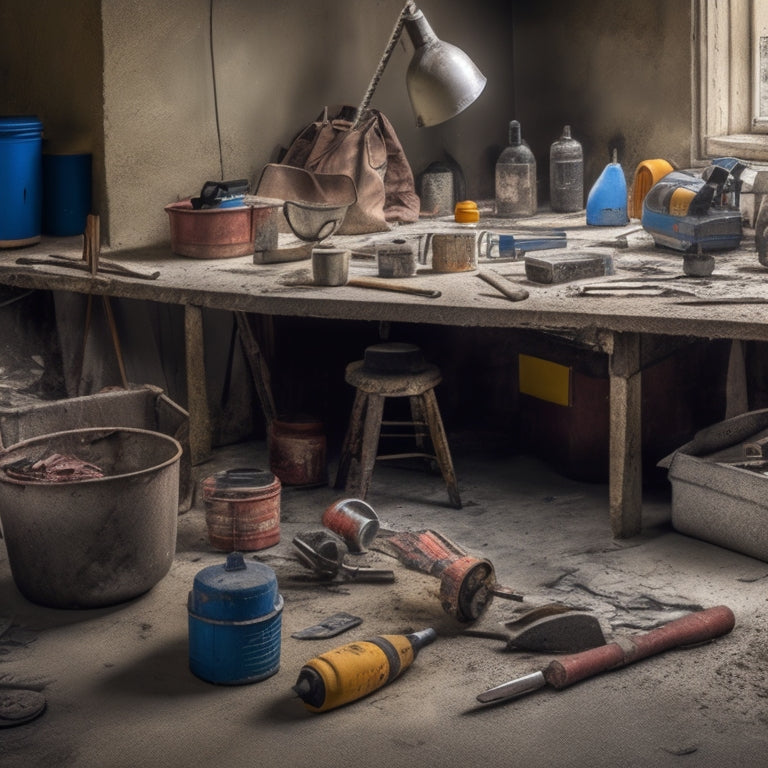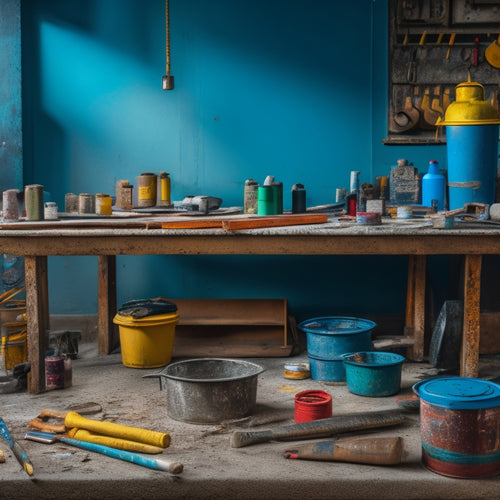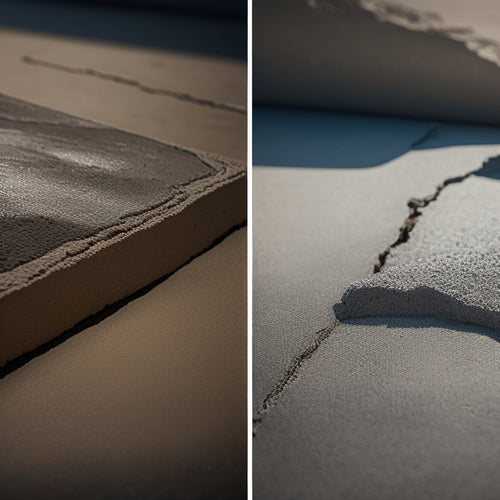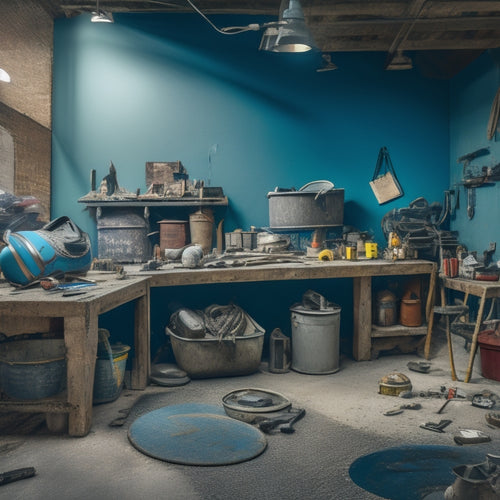
3 Best Concrete Repair Tools for Homeowners
Share
You'll need a crack chasing saw or grinder, a wire brush, and a trowel to guarantee a strong bond between the old concrete and new filling material, and a smooth, durable finish. These essential tools will help you prepare the crack, remove dirt and contaminants, and spread and level the filler material. Additionally, consider investing in a crack width gauge, finishing float, and texture application tool to achieve a professional-looking finish. With these must-haves in your toolkit, you'll be well on your way to a successful concrete repair - and by exploring further, you'll uncover even more expert tips to ensure a long-lasting result.
Key Takeaways
• A crack chasing saw or grinder is essential for widening and cleaning cracks before filling for a strong bond.
• A wire brush or scrub brush is necessary for removing dirt and contaminants from the crack surface.
• A trowel is used to spread and level filler material, feathering edges for a smooth finish.
• A finishing float is necessary for achieving a smooth surface finish, working in small sections.
• A tool maintenance kit is required for cleaning and lubricating tools to prevent filler buildup and ensure tool longevity.
Choosing the Right Filling Material
When tackling a concrete repair project, you need to select a filling material that matches the original concrete's strength, durability, and texture to guarantee a seamless and long-lasting fix. This is vital because incompatible filling materials can compromise the repair's integrity, leading to further damage or even safety hazards.
To ascertain material compatibility, you should consider factors such as the original concrete's compressive strength, aggregate size, and color.
You'll find a wide range of filling materials on the market, each with its own strengths and weaknesses.
Epoxy-based fillers, for instance, offer excellent bonding properties and are ideal for high-traffic areas. Polyurethane-based fillers, on the other hand, provide superior flexibility and are often used for joints and cracks. Acrylic-based fillers are a popular choice for their ease of use and fast-drying properties.
Essential Tools for Crack Preparation
You'll need a set of specialized tools to properly prepare cracks for repair, ensuring a strong bond between the old concrete and the new filling material. Crack preparation is an essential step in the repair process, and having the right tools will make all the difference.
Here are the necessary tools you'll need for crack preparation:
-
Crack chasing saw or grinder: For widening and cleaning the crack, removing any debris or loose concrete.
-
Wire brush or scrub brush: For removing dirt, dust, and other contaminants from the crack surface, ensuring a clean surface for the filling material.
-
Crack assessment tools (e.g., magnifying glass, crack width gauge): For evaluating the crack's width, depth, and orientation to determine the best repair approach.
- Tool maintenance kit: For keeping your tools in good condition, including cleaning and lubricating them regularly to prevent rust and wear.
Smoothening the Filled Surface
With the crack filled, it's crucial to smoothen the surface to a finish that's even with the surrounding concrete, ensuring a seamless repair. You'll need a few specialized tools to achieve a professional-looking result.
First, use a trowel to spread and level the filler material, feathering it out towards the edges. Next, grab a finishing float to smooth out the surface, applying gentle to moderate pressure depending on the texture you're aiming for.
For a more refined finish, switch to a steel trowel or a surface finishing tool, which will help you achieve a smooth, even surface. If you need to replicate the original texture, consider using a texture application tool or a texture mat.
These tools will help you recreate the subtle imperfections and patterns found in the surrounding concrete. Remember to work in small sections, cleaning your tools frequently to prevent the buildup of dried filler material.
Frequently Asked Questions
How Do I Prevent Further Damage After Repairing a Concrete Crack?
After repairing a concrete crack, you'll want to prevent further damage.
To do so, adopt crack prevention techniques like sealing the repaired area with a waterproof coating and applying a concrete sealer to the entire surface.
Regularly inspect your concrete for signs of wear and tear, and address issues promptly.
Follow maintenance tips like cleaning the surface regularly and avoiding harsh chemicals.
Can I Use Concrete Repair Tools on Colored or Stamped Concrete?
As you venture into the world of concrete repair, you're likely wondering if those tools are compatible with your prized colored or stamped concrete.
The answer is, it depends. For colored concrete, you'll want to guarantee the repair tools and materials you choose won't affect the color or texture.
When it comes to stamped concrete, you'll need to adapt your repair techniques to match the original stamping pattern.
Are Concrete Repair Tools Suitable for Repairing Large Cracks or Holes?
When tackling large cracks or holes, you'll need specialized techniques and tools.
For large cracks, you'll want to employ techniques like routing, cleaning, and sealing to guarantee a strong bond.
Hole patching methods involve filling, compacting, and finishing to match the surrounding surface.
With the right tools and methods, you can achieve a seamless repair that lasts.
Do I Need to Seal the Repaired Area After Filling and Smoothening?
After filling and smoothening, you'll want to seal the repaired area to protect it from further damage.
This step is essential, as it guarantees the repair lasts.
You'll have various sealing options to choose from, depending on the type of concrete and the environment it's exposed to.
Familiarize yourself with different repair techniques and sealing methods to select the best approach for your specific situation.
How Long Does a Concrete Repair Typically Last Before Needing Reapplication?
When you complete a concrete repair, you'll want to know how long it'll last.
Typically, a well-executed repair can last 5-10 years before needing reapplication, depending on environmental factors and maintenance.
To extend repair longevity, you'll want to follow maintenance tips like sealing the area, keeping it clean, and avoiding heavy traffic.
Conclusion
You've successfully repaired your concrete surface!
According to the American Concrete Institute, concrete repair is a $2.5 billion industry, and with the right tools, you've just contributed to that statistic.
With the best concrete repair tools, you've guaranteed a strong and durable fix.
Remember, proper preparation and smoothing are key to a long-lasting repair.
By choosing the right filling material and using essential tools for crack preparation and smoothening, you've saved yourself from costly future repairs.
Related Posts
-

Essential Tools for Painting Concrete Walls
When painting concrete walls, you'll need a range of specialized tools to achieve a professional-looking finish. Star...
-

What Tools Ensure Strong Concrete Adhesion at Home
You'll need the right tools to guarantee strong concrete adhesion at home. For surface preparation, use concrete surf...
-

What Tools Do You Need for Concrete Flooring
You'll need a thorough arsenal of specialized tools to achieve a high-quality, professional-looking concrete floor, i...


